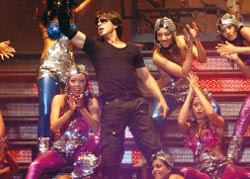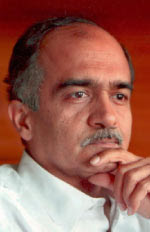For some, it is a moral and ethical issue; for some it's just about making a quick buck - but the undeniable trend of cine stars turning into dancers for hire presents a strange quandary, discovers Subhash K Jha
The dancing kings and queens of Bollywood are at it. Their great skills at popular entertainment are up for sale at the right price, at any venue and occasion. That some of our hottest A-listers would be dancing at a wedding at a gutka baron’s home in Delhi just reiterates what the forever-quotable Shah Rukh Khan had said when the wave of private dancing had started, “I am a bhand (street entertainer) for rent. Anyone can hire me for a price.”
Bhand or no,
 stars seem to be up for sale to anyone who can afford them. Years ago Mamta Kulkarni (remember her?) had sent shock waves across Bollywood when she had danced at a cheesy politician’s private party in Jharkhand. In his inimitable way Shatrughan Sinha had quipped, “Bhai, kyun nahin (why not?)? In the olden days we had raj nartakis dancing in the king’s darbaar. We now have our filmi nartakis dancing for politicians. This is just carrying a tradition forward.”
stars seem to be up for sale to anyone who can afford them. Years ago Mamta Kulkarni (remember her?) had sent shock waves across Bollywood when she had danced at a cheesy politician’s private party in Jharkhand. In his inimitable way Shatrughan Sinha had quipped, “Bhai, kyun nahin (why not?)? In the olden days we had raj nartakis dancing in the king’s darbaar. We now have our filmi nartakis dancing for politicians. This is just carrying a tradition forward.”Mamta had raised eyebrows by dancing for a politician. Today when A-listers from Bollywood agree to shake a limb and butt at a gutka king’s residence no one within the film industry is angered into protest.
One topnotch actor who absolutely refuses to get jiggy at private functions did tell me wryly, “Mamta danced for a politician. I hear Katrina is dancing for a gutka king. Which is worse? Depends on which is more harmful to your health. Gutka or politics? I’d never dance (privately) no matter what the price tag. To me it’s humiliating to even consider putting myself up for exhibition at someone’s son mundan ceremony or daughter’s wedding. I don’t mind making a brief appearance to say hello.”
Stars now charge money even to shake hands at weddings and birthdays. A few months ago Bipasha Basu underwent a horrific experience in Delhi where she had agreed to attend a private party for half an hour.
Recalls Bipasha, “I came to know it was actually the birthday party of the hotel owner. I refused to attend because the profile and guest attendance at a birthday party would be something different. I heard there were sozzled people and belly dancers among the invitees. There was loud music blaring across hotel and I could hear it in my room. Early in the day I told them I wouldn’t attend the party. At 1.30 am when I was sleeping, I was woken up with this crazy banging on my door. The voices from outside were demanding me to open the door.”
It was much later that Bipasha got to know that her bouncers had been removed from the hotel premises and that there were TV cameras from channels out there who had been informed that she had taken money to attend the party and then refused to do so.
Defends Bipasha, “I was shivering and crying inside. Even if I had taken money to attend the party, what gave these people the right to bang on my hotel door at that unearthly hour when I’m supposed to be safe and protected? Later I got to know there were hotel staff and also crime reporters from the channels banging on my door. Crime reporters!!! What crime had I committed? My business manager and make-up girl were outside the door going hysterical with terror trying to keep those men from breaking down my door. I could hear leery slurring voices saying, "Ladki hai varna darwaza tod denge." The kind of rudeness and trauma we three girls were subjected to is unbelievable.”
Since then Bipasha has been very careful about the events she attends. But would our other young attractive stars ever learn their lesson?
A very hot and happening actress who is always in and out of private functions had once said to me, “What is there? I just need to be there, do a few steps and get paid well. It makes them all happy. It makes me happy and richer by a few crores. But don’t write about it.”
“If you pay me I’ll dance even at your birthday,” one of today’s top leading ladies had challenged me. A far cry from the time when even a public classical performance was considered infra dig by our entertainment industry’s luminaries. Asia’s Nightingale Lata Mangeshkar fobbed off all the lucrative offers for performing at public concerts until the late 1960s. Her rationale? She is a playback singer, not a stage performer.
Lataji recalls, “Before I did my first live concert at the Royal Albert Hall in London in 1969 my stage appearances were sporadic. I’d join my colleagues from the music industry to sing a few songs at charity concerts and then flee from the scene. The Albert Hall concert was done after innumerable requests. I did it on condition that the venue has to be of historical significance.”
Vyjayanthimala was the first screen queen who actually danced on stage, at the Filmfare awards, and that too on condition that her performance be purely classical and not filmy. In fact, when Asha Parekh and Hema Malini began performing on stage they made sure that they were not required to do any of their filmy dancing. When Vyjayanthimala went on tour of the West Indies in 1970 and the audience asked for her tantalising “Buddha Mil Gaya”, the elegant Tamil actress walked off the stage.
Ditto for Hema Malini. At a dance performance in Trinidad in 1972, Hema haughtily huffed off the stage when audiences clamoured for her filmy dances. I was present at that concert. Laughs the Dream Girl, “You were there? Yes, I’d as a rule walk out if audiences clamoured for glamour. I’m very clear that my stage performances are for my classical dancing. If you want to see me doing my film dances you’ve to see my films. Today the girls are dancing at private functions to make quick money.”
In her characteristically candid style Hema hits the nail on the head. If topnotch stars are willing to dance at private functions then blame the recession. Many of our top heroines are doing much less work on screen than they’d like to. Either the roles are too routine. Or the money too mundane. Why not just attend a function, wave to the crowds, do a jig and go home while the happy host sings “Jiggy jab se tu aaya mere dware….”
Yup, stars at your doorstep for a price. And barring a few like Ajay Devgn, Imran Khan and Ranbir Kapoor, who won’t be caught dead dancing for weddings and funerals, stars seem to not mind this quick-money scheme at all, specially during these time of acute recession when barring a handful of stars no one is making instant money.
But then why would Shah Rukh Khan, Salman and Katrina Kaif who command staggering fees on celluloid and have more assignments on offer than they can handle, choose to gallop into the gutka gallery? Maybe they want to use the money to help victims of mouth cancer?
The ever-pragmatic Mahesh Bhatt jumps to the defence of modern-day raj-nartakis. Says Bhatt, “A star is a commodity with a price tag in the cultural supermarket. I have no issues with them dancing at shaadis.” Subhash Ghai’s no-objection certificate for private star-performances is conditional. “Stars have every right to make as much money as they want from sources other than films as long as the dates allotted to producers, which is the stars’ core commitment, is not hampered just because they get extra money. It’s a crime to cut producers’ dates or to give preference to stage appearances, thereby making producers bear heavy losses. Such actors and actresses have no work ethics.”
Stars are so enamoured of the quick money offered at these private functions that they report sick to producers and sneak off for a bit of fun money on the sly. Curiously, most stars don’t want to talk about their presence at private events. Two years ago Akshay Kumar and Priyanka Chopra had danced live at a diamond merchant’s son wedding in Mumbai hoping no one would notice.
Right! With 2000 guests watching them and Akshay making a grand entrance on horse, the chances of going unnoticed were really high. Ha ha!
Why are stars embarrassed about their wed-and-wild appearances when they are paid upfront for their starry contribution to moneyed marriages? Sighs producer-director Suneel Darshan, “These public appearances by stars are signs of the changing times, rules and values. What was cinema earlier is now the entertainment industry.”
Adds Shailendra Singh whose company Percept arranges many a filmy razzmatazz, “Exploitation of your talent for monetary gains is not incorrect as long as what you do is not morally or socially wrong or doesn’t hurt your brand or image. I personally don’t think dancing at weddings is cool for stars’ images.”
Producer-director Vipul Shah whose favourite star, Akshay Kumar, has no qualms being a private entertainer, jumps at the defence of these public commodities, “Why not? When stars dance for private events the people behind these events feel special and happy. What’s wrong with that? Would anyone talk about it if stars didn’t charge a fee? Let the stars earn and make money as well.” Writer-director Abbas Tyrewala seconds that motion. “They’re performers and make their living performing. If some stars have taken their popularity to the point where they are paid crores for a private function then I say, more power to their tribe.”
Adds Pooja Bedi, “If they can do it for corporate events, fashion shows and product launches, why not weddings which are the most important day of some people’s lives?”
Only the outspoken Sanjay Gupta dares to openly castigate stars for their wedding wows, “I think it totally takes away from the stars’ persona. Can you imagine Mr Bachchan dancing at weddings? There’re so many avenues today for stars to make money. Why dance at weddings?” While the discussion on the moral ethical and financial feasibility of stars performing privately rages on, some of the newer hot-listers have quietly taken a stand against the private jiggle-bandi.
Imran Khan recently said to me, “I’m offered obscene amounts of money to make appearances at private functions. But, no thanks.” Ranbir Kapoor also feels dancing for money at weddings is “not happening.” Sonakshi Sinha would never dance at private functions.
The choice is clear. Obscene money. Or just obscene?
For More IIPM Info, Visit below mentioned IIPM articles.
Management Guru Arindam Chaudhuri Dean Business School IIPM
IIPM Excom Prof Rajita Chaudhuri
Kapil Sibal's voters want Jan Lokpal, not Government-proposed Lokpal Bill
What is E-PAT?
Item Numbers Are The New Mantras of Bollywood
IIPM, GURGAON
Noida Extn dreams breaks as court scraps new acquisition
IIPM: Leading consistently on multiple fronts
Anna Hazare Jan Lokpak Bill Vs Government Lokpal Bill




